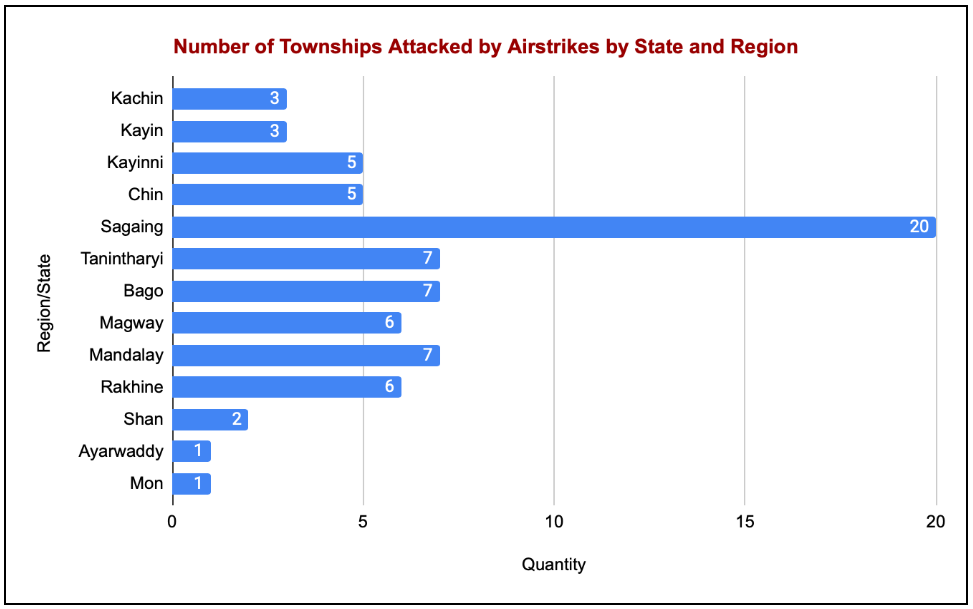And the Death Comes from the Sky
- Myanmar Internet Project
- May 21
- 4 min read
Interpreting Airstrikes in Post-Quake Ceasefire in Myanmar
After the intensifying earthquake on March 28, 2025, the junta announced a ceasefire from April 2 to April 22, 2025. Moreover, it extended the ceasefire declaration until the end of April. However, despite the announcement, the junta continued to carry out airstrikes and ground offensives.
Myanmar Internet Project (MIP) documented 137 airstrike cases that occurred during the two ceasefire periods declared by the junta, based on reports from independent and local media outlets.
The facts included in the report were analyzed based on the 137 airstrike cases documented by MIP.
Situation of Townships Affected by Airstrikes
During the two ceasefire periods, the junta carried out the airstrike attacks in the 73 townships across 13 regions and states. According to the internet shutdown data that was collected by the MIP, 66 out of 73 townships experienced connectivity disruptions including internet shutdowns.
Number of Townships Attacked by Airstrikes by State and Region
During the two ceasefire periods, at least 20 townships across Sagaing Region suffered airstrike attacks.
A state of emergency was declared in six regions - including Sagaing, Mandalay, Bago, and Magway Regions, Eastern Shan State, and Nay Pyi Taw - where casualties occurred and many buildings were damaged due to the intensifying earthquake crisis. At least 40 townships - including those in the state of emergency areas: 20 in Sagaing, 7 in Mandalay, 6 in Magway, and 7 in Bago - came under airstrike attacks.
Airstrike Impact by Each Region and State
According to the 137 airstrike incidents documented by the Myanmar Internet Project (MIP), it was found that 43 occurred in 20 townships within the Sagaing Region, while 24 took place in 7 townships within the Mandalay Region.
Airstrike Incidents by State and Region
In the four Regions - Sagaing, Magway, Mandalay, and Bago Divisions - including the State of Emergency, at least 48 airstrike attacks were experienced. That is to say, 60.59 percentages of airstrike attacks occurred in areas severely affected by the earthquake.According to the internet shutdown data that were collected by MIP, among the 40 townships across four divisions that experienced airstrikes and were included in the declared state of emergency, 33 of them were also townships that faced internet shutdowns.
Daily Airstrike Operations
According to an analysis of 137 documented airstrike incidents by the Myanmar Internet Project (MIP), it proved that airstrikes continued on a daily basis throughout both officially declared ceasefire periods.
Junta Daily Airstrikes During the Ceasefire Period
Impact on Civilians: Deaths and Injuries from Airstrikes
According to an analysis of 137 documented airstrike incidents by the Myanmar Internet Project (MIP), during both officially declared ceasefire periods, at least 201 individuals were killed and 268 were wounded as a result of junta-led airstrikes. (In some airstrike incidents, the exact number of those killed and injured were not clearly specified, making it impossible to include them in the calculation. In that situation, killed and injured may be significantly higher than the figures currently presented.)
Civilians Deaths and Injuries Due to Airstrikes
Due to airstrike attacks, there were a total of 12 mass casualty incidents resulting from airstrikes — 9 of which involved the deaths of 5 or more individuals, and 3 involving 10 or more fatalities.There were incidents in Latekya Village, Yay Hwat Village, where 27 individuals were killed, and Nan Khan Village, where nearly 30 individuals lost their lives. A total of 97.5% of individuals killed in airstrikes were residing in areas experiencing internet and mobile communication shutdowns.
Civilian Wounded and Casualties by Region and State
Due to airstrike attacks, 86 individuals from Sagiang, 50 individuals from Mandalay, 8 individuals from Magway, and 10 individuals from Bago were killed. It was observed that a total of 76.61% of individuals who lost their lives were residented in areas under a declared state of emergency due to the intensifying earthquake.
Social Infrastructure Damaging
Due to the junta’s airstrike attacks, a number of social infrastructure sites - including hospitals or clinics, schools, and religious buildings - were damaged. According to 137 airstrike incidents documented by the Myanmar Internet Project (MIP), it was found that 3 schools, 9 clinics/hospitals, and 14 religious buildings were damaged in the attacks.
Damage to Social Infrastructure Caused by Airstrikes
Damage to religious buildings was observed in 10% of the airstrike incidents, while damage to hospitals or clinics was recorded in 6.56% of the incidents. Damage to residential buildings are present in 20% (1 out of 5) of airstrike cases - highlighting discriminate targeting of the populace and risk of internally displaced persons. Additionally, internet shutdowns were consistently observed along with indiscriminate targeting of civilian residential buildings.
Finding
At least 40 townships that were included in the state of emergency areas due to the intensifying earthquake came under airstrike attacks during the ceasefire period.
66 out of 73 townships that experienced airstrike incidents also suffered connectivity disruptions including internet shutdowns.
A total of 97.5% of individuals killed in airstrikes were residing in areas experiencing internet and mobile communication shutdowns.
All social infrastructure damage occurred in areas affected by the connectivity disruptions.
Recommended Citation Style - Myanmar Internet Project(2025, May 21), And the Death Comes from the Sky, https://www.myanmarinternet.info/post/earthquake_airstrike_21_may_2025-1


















Comments